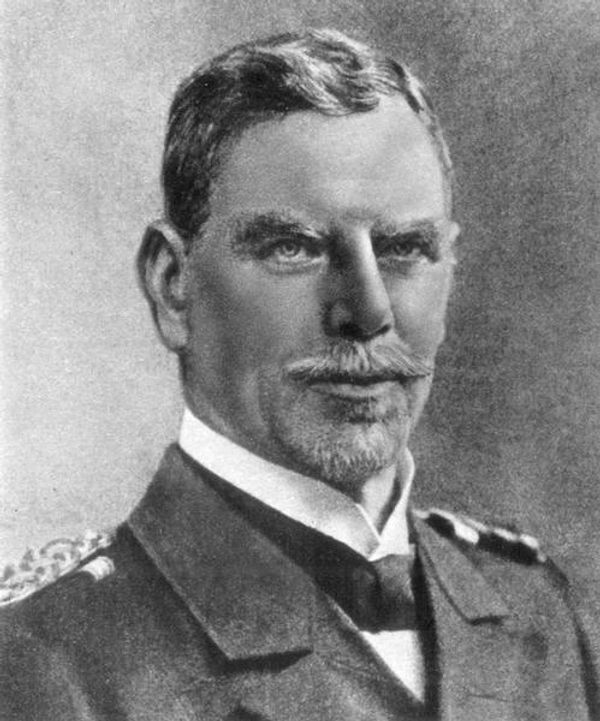Battles of Coronel & the Falklands
The Battle of Coronel - 1st November 1914
At the outbreak of the First World War, Germany’s East Asiatic Squadron, under the leadership of Count Maximilian von Spee, was trying to evade the British and Japanese as he sailed eastwards across the Pacific.
On 1st November 1914, the British Squadron, led by Admiral Sir Christopher Cradock, engaged von Spee at Coronel, off the Chilean coast.
Von Spee’s squadron was made up of Scharnhorst (flagship), Gniesenau, Dresden, Leipzig, Nürnberg, Baden (collier) and Santa Maria (collier)
Craddock’s out-dated cruisers Good Hope and Monmouth, light cruisers Otranto and Glasgow and the aging pre-dreadnaught Canopus (in reserve), were no match for the modern German flotilla - the Good Hope and Monmouth were lost with all hands and the others retreated to the Falkland Islands.
Coronel was a disastrous defeat for Britain, with nearly 1,600 crew lost.

Good Hope, Glasgow and Monmouth off to Coronel

Admiral Sir Christopher Cradock

Admiral Maximilian von Spee

HMS Glasgow

HMS Good Hope

HMS Glasgow & HMS Good Hope

HMS Canopus

Admiral Cradock's squadron
The Battle of the Falklands - 8th December 1914
The Royal Navy took decisive action to destroy von Spee - the battle cruisers HMS Invincible and HMS Inflexible were quickly despatched to the South Atlantic under Vice-Admiral Sir Doveton Sturdee. They were to rendezvous with other British vessels off the Brazilian coast and sail for the Falklands.
Admiral von Spee lingered in the Pacific before finally deciding to make for Germany through the Atlantic and, although his captains were opposed to the idea, von Spee made the fateful decision to raid the Falkland Islands.
On December 7th, Sturdee arrived at Stanley where HMS Canopus was already beached in the harbour on guard duty. The squadron now comprised of battle cruisers - HMS Invincible (flagship) and HMS Inflexible, armoured cruisers - HMS Kent, HMS Carnarvon and HMS Cornwall, light cruisers - HMS Bristol and HMS Glasgow and armed merchant cruiser - HMS Macedonia.
The flotilla began coaling, in readiness to resume the search for the German squadron. Early in the morning of December 8th, the German squadron was spotted off Stanley. The British ships, still coaling, would have taken a couple of hours to get up full steam and would have been sitting targets had von Spee chosen to come into Stanley.
Canopus, beached out of sight of the German ships, fired over the land at the enemy and a blank shell (which had been loaded for a practice shoot) ricocheted off the sea and hit the Gneisenau. The German ships turned away. Canopus, which had been unable to fire a shot at Coronel, had saved the British fleet from a perilous situation.
The German squadron had a 15-20 mile lead by the time the British ships had made steam (by 9.45am most of the British ships were in pursuit), but with more than 8 hours of daylight left and fine weather, chances of catching von Spee were good. By 1.00pm the rear ships of the German column were within firing range of Invincible and Inflexible. The battle then became several separate engagements: Invincible and Inflexible engaging Scharnhorst and Gneisenau,
Cornwall and Glasgow engaged the Leipzig, Kent went after Nürnberg with the fastest German ship, Dresden, escaping.
By 6.00pm, the Gneisenau and Scharnhorst, with von Spee aboard, were sunk. With the exception of the Dresden, all the other German ships were also sunk, along with two colliers. Dresden was later scuttled when cornered by her pursuers.
This was a decisive victory that secured naval supremacy in the South Atlantic for the rest of the war.

HMS Inflexible picking up German survivors

HMS Bristol
HMS Kent

HMS Invincible

SMS Sharnhorst

HMS Inflexible & Invincible

HMS Invincible
Local Participation in the Battle of the Falklands
News of the defeat at Coronel caused great anxiety in the Falklands and after a Council of War at Government House on November 6th, women and children were urged to leave Stanley and the Volunteer Force was put on high alert.
On November 12th a warship was spotted heading for Stanley - alarm bells were sounded at the Cathedral and in the Dockyard, and the Volunteers mustered. Happily, the ship turned out to be the Canopus which had been instructed to return and protect the wireless station at Stanley.
Chris Andreasen - On the morning of December 8th, Christian Andreasen (a Danish sailor who had been in the Islands since 1907) and was a member of the Volunteer force, spotted the German fleet from his lookout post on the top of Sapper’s Hill.
Andreasen’s accurate and swift reporting earned him the admiration and gratitude of Admiral Sturdee who, after the action, thanked him personally and presented him with a £5 note. Andreasen was also presented with a gold watch by the Lords Commissioners of the Admiralty.
Muriel Felton - Christina Goss and Marion McLeod, maids to Mrs. Felton of Fitzroy, were out riding on the morning of the Battle and spotted the German fleet approaching. They swiftly rode back to report the sighting which Mrs. Felton telephoned through to the War Office in Stanley. The maids were sent back to Fitzroy Ridge and with the help of houseboy Albert Kiddle, relayed the ships movements.
The Lords Commissioners of the Admiralty presented Christina and Marion with a silver teapot while Mrs. Felton was awarded an OBE for notifying the fleet - the first OBE awarded to a Falkland Islander.

Gold Watch presented to Chris

Christian Andreason

Silver Teapot presented to Christina and Marion

Mrs. Felton receiving her OBE
Falkland Islands Museum & National Trust
Historic Dockyard Museum - Stanley - Falkland Islands
This website uses cookies.
We use cookies to analyze website traffic and optimize your website experience. By accepting our use of cookies, your data will be aggregated with all other user data. Privacy Policy
